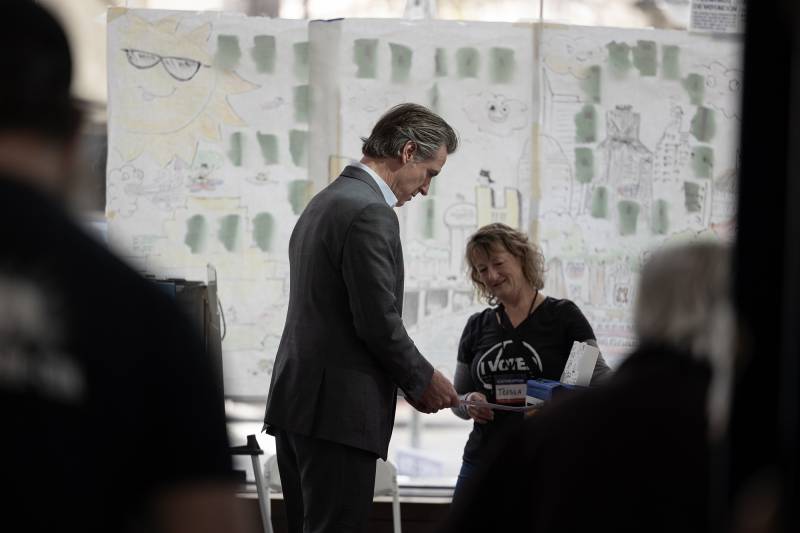“This is exactly where we thought we’d be,” Anthony York, a spokesman for the Yes on Proposition 1 campaign, said on Wednesday. “There are 2 to 3 million ballots outstanding. I’d say we’re cautiously optimistic.”
In contrast, the opposition campaign raised very little money. Opponents are led by clients of mental health services and some small mental health agencies who worry their programs could lose funding if the measure passes. Others, including the Howard Jarvis Taxpayers Association, opposed the measure because of its cost.
Paul Simmons, executive director of the opposition campaign, struck a hopeful tone as early votes started rolling in Tuesday night.
“We expected to be further behind in the early voting,” Simmons said. “This being at 51% or 50% is very encouraging to me.”
Recent polling casts uncertainty over what many initially considered an easy win for the governor. Fifty percent of likely voters supported the measure a week ago, according to the latest poll by UC Berkeley’s Institute of Governmental Studies. The poll tallied opposition at 34% and undecided at 16%.
Proposition 1 needs a simple majority of the vote to pass.
Jon Coupal, executive director of the Howard Jarvis Taxpayer Association, said the results so far show that Californians are concerned about government spending.
“This has two strikes. No. 1, it was a bond measure. People are sensitive right now to government debt. A lot of people had the reaction of, ‘I’m all for helping the homeless, but do we really need a bond to do this?’
“Then secondly, I think people are well aware of the billions of dollars we have thrown at homelessness and mental health and the problem just seems to get worse, so I think people may look at that and say, you’re asking for more money, and you’re not demonstrating any results,” he said.
Here’s a look at what the measure would do.
What does Proposition 1 promise?
The dual bond measure and change to California’s so-called “millionaire’s tax” are Newsom’s attempt to increase the state’s mental health and addiction treatment capacity and get people living in encampments into stable housing.
The number of unhoused Californians had ballooned to 181,000 people in 2022 during the most recent point-in-time count, a 60% increase over the past decade. New research from UCSF estimated that more than 21,000 homeless people currently experience hallucinations. Meanwhile, the number of acute care mental health hospital beds decreased by at least 30% between 1995 and 2016, according to the California Hospital Association.
The bond measure is supposed to build a combined 11,150 treatment beds and housing units, with some set aside for veterans.
Where will the money go?
Money raised by the bond would be funneled into two existing state programs: the Behavioral Health Continuum Infrastructure Program and Project Homekey.
The behavioral health program would get a $4.4 billion infusion to build 6,800 in-patient mental health and substance use disorder treatment beds. The Department of Health Care Services will award grants to counties and local organizations to construct, acquire and expand treatment capacity. To date, the department has awarded more than $1.6 billion to a variety of programs, including crisis care and children’s facilities, as part of a pre-existing budget investment.
Project Homekey would get $2 billion to build 4,350 units of supportive housing for people with mental health and addiction challenges. A little more than half of the units will be reserved for homeless veterans. Project Homekey is an extension of Newsom’s pandemic-era efforts to house people living in encampments during the height of the COVID-19 pandemic. The state budget previously gave the Department of Housing and Community Services $736 million to convert hotels, motels and other buildings into housing.
How much will it cost?
Bonds allow government agencies to borrow money and repay debt over time. Proposition 1 is estimated to cost $310 million annually over 30 years, totaling $9.3 billion, according to the nonpartisan Legislative Analyst’s Office. Payments would be made from the state general fund.
California faces state budget cuts for the second consecutive year, with some estimates projecting a $73 billion shortfall.
What other changes have happened recently?
Newsom has made mental health a signature issue. If Proposition 1 passes, it would represent another milestone in his overhaul of California’s behavioral health system.
Last year, Newsom signed a law easing restrictions on California’s decades-old conservatorship law, which limits who can be placed in involuntary treatment programs.
In 2022, his signature mental health push established a special court system to compel people with untreated mental health and addiction challenges into treatment programs.
And in 2021, Newsom poured more than $4 billion in one-time funds into children’s programs to address rising suicide rates and overdoses among youth.
Who opposed it and why?


